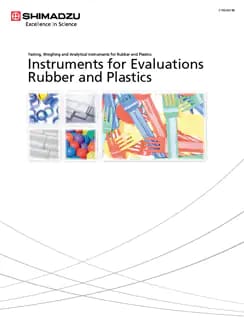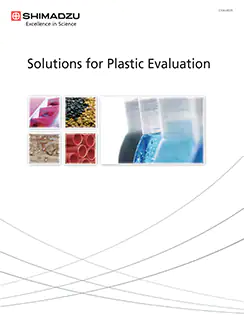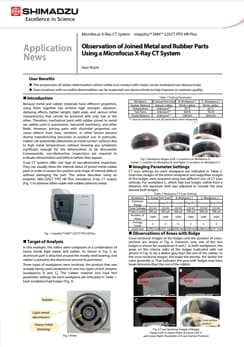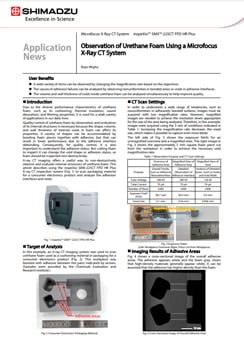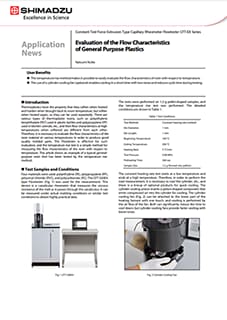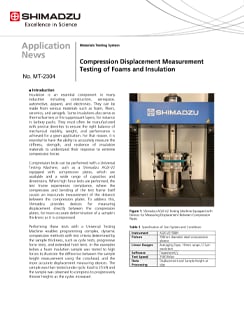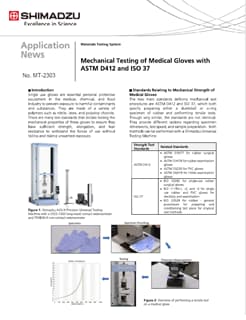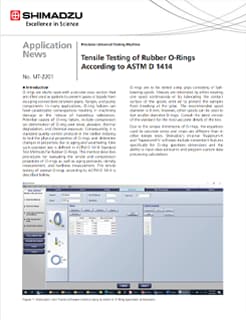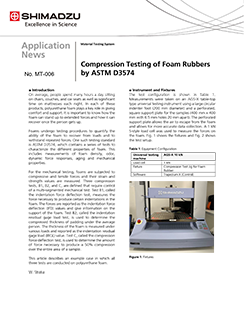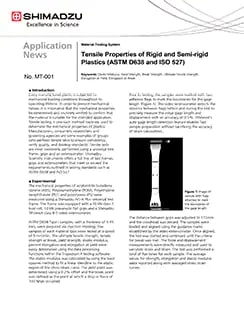Plastics, Polymers, and Rubber Materials Testing
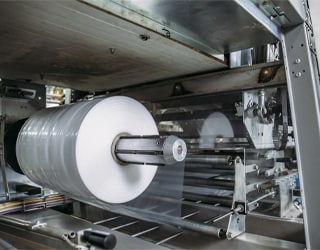
Testing, Analysis, and Inspection of Plastics, Polymers, and Rubber
Engineering plastics such as acrylonitrile butadiene styrene (ABS), polycarbonates, and polyamides are increasingly used in automotive and other high-performance applications. Shimadzu offers a complete range of instruments to characterize the composition and thermal and mechanical behavior of plastic materials.
Below are a few examples:
Instruments for Evaluations of Rubber and Plastics
Rubber and plastic products are used in a wide variety of areas. Evaluations of their basic performance and the components that determine their performance are indispensable for product development and quality control. Shimadzu not only offers a wide array of evaluation instruments, it also provides comprehensive support from application to after-sales service.
Solutions for Plastic Evaluation
Shimadzu instruments for solutions for plastic material evaluation including the evaluation of plastic materials, evaluation of raw materials, product evaluation, and product evaluation.
Observation of Joined Metal and Rubber Parts Using a Microfocus X-Ray CT System
Because metal and rubber materials have different properties, using them together can achieve high strength, vibrationdamping effects, lighter weight, tight seals, and various other characteristics that cannot be achieved with only one or the other. Therefore, mechanical parts with rubber joined to metal are widely used in automotive, industrial machinery, and other fields. However, joining parts with dissimilar properties can cause defects from heat, vibration, or other factors present during manufacturing processes or product use. In particular, rubber can potentially deteriorate at metal contact surfaces due to high metal temperatures without showing any symptoms significant enough for the deterioration to be discovered. Consequently, non-destructive inspections are required to evaluate deterioration and defects before they appear. X-ray CT systems offer one type of non-destructive inspection. They can visually show the internal status of joined metal-rubber parts in order to assess the position and shape of internal defects without damaging the part. This article describes using an inspeXio SMX-225CT FPD HR Plus microfocus X-ray CT system (Fig. 1) to observe rollers made with rubber joined to metal.
Observation of Urethane Foam Using a Microfocus X-Ray CT System
Due to the diverse performance characteristics of urethane foam, such as its cushioning, thermal insulation, sound absorption, and filtering properties, it is used for a wide variety of applications in our daily lives. Quality control of urethane foam by observation and evaluation of itsinternal structuresis necessary because the shape, volume, and wall thickness of internal voids in foam can affect its properties. A variety of shapes can be accommodated by bonding foam pieces together with adhesive, but that can result in lower performance due to the adhesive interface debonding. Consequently, for quality control, it is also important to understand the adhesive status. But cutting foam to inspect it can change the void shape or adhesion status, so foam should be inspected non-destructively. X-ray CT imaging offers a useful way to non-destructively observe and evaluate internal structures of urethane foam. This article describes using the inspeXio SMX-225CT FPD HR Plus X-ray CT inspection system (Fig. 1) to scan packaging material for a consumer electronics product and analyze the adhesion interfaces and voids.
Evaluation of the Flow Characteristics of General Purpose Plastics
Thermoplastics have the property that they soften when heated and harden when brought back to room temperature, but soften when heated again, so they can be used repeatedly. There are various types of thermoplastic resins, such as polyethylene terephthalate (PET) used in plastic bottles and polypropylene (PP) used in kitchen utensils, etc., and their flow characteristics at high temperatures when softened are different from each other. Therefore, it is necessary to evaluate the flow characteristics of the resin material at various temperatures in order to produce good quality molded parts. The Flow tester is effective for such evaluation, and the temperature rise test is a simple method for measuring the flow characteristics of the resin with respect to temperature. This article shows an example of a typical general purpose resin that has been tested by the temperature rise method
Compression Displacement Measurement Testing of Foams and Insulation
Insulation is an essential component in many industries including construction, aerospace, automotive, apparel, and electronics. They can be made from various materials such as foam, fibers, ceramics, and aerogels. Some insulations also serve as thermal barriers or fire suppressant layers, for instance in battery packs. They must often be manufactured with precise densities to ensure the right balance of mechanical stability, weight, and performance is achieved for a given application. For that reason, it is essential to have the ability to accurately measure the stiffness, strength, and resilience of insulation materials to understand their response to extreme compressive forces.
Mechanical Testing of Medical Gloves with ASTM D412 and ISO 37
Single use gloves are essential personal protective equipment in the medical, chemical, and food industry to prevent exposure to harmful contaminants and substances. They are made of a variety of polymers such as nitrile, latex, and polyvinyl chloride. There are many test standards that dictate testing the mechanical properties of these gloves to ensure they have sufficient strength, elongation, and tear resistance to withstand the forces of use without failing and risking unwanted exposure.
Tensile Testing of Rubber O-Rings According to ASTM D 1414
O-rings are elastic seals with a circular cross section that are often used as gaskets to prevent gases or liquids from escaping connections between pipes, flanges, and pump components. In many applications, O-ring failures can have catastrophic consequences resulting in machinery damage or the release of hazardous substances. Potential causes of O-ring failure, include compression set (deformation of O-ring over time), abrasion, thermal degradation, and chemical exposure. Consequently, it is standard quality control protocol in the rubber industry to test the physical properties of O-rings and determine changes in properties due to aging and weathering. One such standard test is defined in ASTM D 1414 Standard Test Methods for Rubber O-Rings. This method describes procedures for evaluating the tensile and compression properties of O-rings as well as aging protocols, density measurement, and hardness measurement.
Compression Testing of Foam Rubbers by ASTM D3574
Foams undergo testing procedures to quantify the ability of the foam to recover from loads and to withstand repeated forces. One such testing standard is ASTM D3574, which contains a series of tests to characterize the different properties of foam. This includes measurements of foam density, odor, dynamic force responses, aging and mechanical properties. For the mechanical testing, foams are subjected to compressive and tensile forces and their strain and strength values are measured. Three compression tests, B1, B2, and C, are defined that require control of a multi-segmented mechanical test. Test B1, called the indentation force deflection test, measures the force necessary to produce certain indentations in the foam. The forces are reported as the indentation force deflection (IFD) values and give information on the support of the foam. Test B2, called the indentation residual gage load test, is used to determine the compressed thickness of padding under the average person. The thickness of the foam is measured under various loads and reported as the indentation residual gage load (IRGL) value. Test C, called the compression force deflection test, is used to determine the amount of force necessary to produce a 50% compression over the entire area of a sample. This article describes an example case in which all three tests are conducted on polyurethane foam.
Tensile Properties of Rigid and Semi-rigid Plastics (ASTM D638 and ISO 527)
Every manufactured plastic is subjected to mechanical loading conditions throughout its operating lifetime. In order to prevent mechanical failure, it is imperative that the mechanical properties be determined and routinely verified to confirm that the material is suitable for the intended application. Tensile testing is one such method routinely used to determine the mechanical properties of plastics. Manufacturers, consumers, researchers and governing agencies are some examples of groups who perform tensile tests to ensure consistency, verify quality, and develop standards. Tensile tests are most commonly performed using a universal test frame, grips and an extensometer. Shimadzu Scientific Instruments offers a full line of test frames, grips and extensometers that meet or exceed the requirements outlined in testing standards such as ASTM D638 and ISO 527.
Testing and Characterization of Biodegradable Plastics
Biodegradable Plastics are plastics that are decomposed into low-molecular compounds by microorganisms in the environment. So they break down easily in nature, which is an opposite characteristic of petroleum-based plastics. They are recommended for single-use products. At this time, it is true they are inferior to petroleum-based plastics in the features of durability and functionality, so research and development of new materials is on going for a reliable solution.
Physical Properties Evaluation of Polymer Materials by Temperature-Modulated DSC

Temperature-modulated DSC (TM-DSC) is a technique that makes it possible to acquire information that cannot be obtained with standard DSC by temperature control in which a modulation is overlaid on a constant temperature increase. In this article, the thermal characteristics of representative polymer materials were evaluated by using the temperature modulation function of the Shimadzu DSC-60 Plus.
Differentiation of Resins in Carbon Fiber Reinforced Plastics (CFRP) by FTIR

The resins used in CFRPs can be differentiated easily by analysis by Fourier transform infrared spectrophotometry (FTIR), FTIR is an effective tool for quality control when determining the resin components of CFRPs before recycling. In this article, thermosetting and thermoplastic CFRPs were measured by FTIR and their component resins were differentiated.
Analysis of Thermally Degraded Plastics Using Thermally Degraded Plastics Library

FTIR is optimal for the analysis of such plastic contaminants. However, the infrared spectrum of degraded plastic differs from the spectral pattern before degradation. Accordingly, in searches using commercially available plastics libraries, even if a search result has top ranking, it can inadvertently consist of the spectral pattern for a different substance, making identification and qualification difficult. In this article, we introduce an example of the changes to the infrared spectrum of a plastic degraded by heat, and a sample search using a library containing data created by changing the heating temperature and time beforehand.
Investigation of Ultraviolet Degradation of Plastic with Mapping Program

Plastic is degraded by ultraviolet light and heat. However, it is difficult to determine how deep degradation reaches into a material based on its external appearance. The extent of degradation inside a material can be confirmed by cutting cross sections of the material and performing mapping analysis with an infrared microscope. We describe an analytical technique that confirms the extent of ultraviolet degradation of polypropylene plastic that is used in various everyday products, and compare the results with visual observation of ultraviolet degradation.
Tensile Test Methods for Plastics: ASTM D638

Resin materials (plastics) are found in a wide variety of items used on a daily basis. Recently, plastics have started to be used as structural materials in transportation equipment, such as automobiles and aircraft, due to their strength and light-weight nature. In these applications, it is important to understand the mechanical strength properties of these plastics. ASTM D638 specifies methods for testing the tensile strength of plastics and other resin materials and for calculating their mechanical properties, and outlines accuracy requirements for the test frames and accessories used.
Analysis of Microplastics by iSpect™ DIA-10 Dynamic Particle Image Analysis System and AIM-9000 Infrared Microscope

Here, we introduce an example of analysis of the shape and particle count concentration of particles contained in environmental water and their qualitative analysis by using a dynamic particle image analysis system and an infrared microscope
Hardness Test of Plastic Materials (ISO/TS 19278:2019)

This article introduces hardness testing conforming to the above-mentioned standard (ISO/TS 19278:2019) by the Shimadzu DUH™-210 Dynamic Ultra Micro Hardness Tester for plastics using representative plastic materials.




